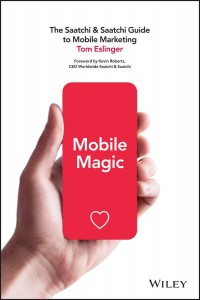Over 6 billion people around the world have access to a mobile device. Time points out that more people have access to a mobile phone than toilets. These devices are now so important to us that they are almost an extension of our bodies.
As a lawyer, I was captivated to see what the Supreme Court would rule in Riley v. California. In a rare 9-0 decision, the Supreme Court recognized the importance of mobile devices and held that the police need a warrant to search cell phones. Even the Supreme Court knows:
Mobile is changing everything.
The Mobile Revolution
Tom Eslinger, Saatchi & Saatchi’s Worldwide Director of Digital and Social is an expert on mobile marketing. His recent book The Saatchi & Saatchi Guide to Mobile Marketing got my attention. It is filled with facts about mobile and a peek into our mobile future. Tom has helped brands like Toyota, Coca-Cola, T-Mobile, Lexus, Visa, Sony Ericsson, Heineken, and Procter & Gamble with mobile, augmented reality and games. Who better than Tom to share insights on how organizations are using mobile today?
You are enthusiastic about mobile (understatement!). Why?
We can see a steady trend over the last five years in major industries, beginning with the retail consumer marketing-structure as it becomes more fluent with mobile technology. Mobile devices have already exceeded desktops. We, consumers, are essentially becoming a culture of detachment and wirelessness. So, having a mobile-first strategy will be critical for any company over the next five years – and perhaps even the next five months.
Tom, what are the top mistakes companies are making with mobile?
1. Don’t Support Your Campaign
The importance of maintaining your mobile presence can’t be stressed enough. Slacking off on maintenance can sabotage the best-laid plans. This means keeping your audience engaged, often at multiple levels of engagement. And of course, you need to pay attention to the stuff that keeps it all going: server networks, customer care, and technical support. You can expect to spend around 1.5 times your creation costs on on-going marketing and program maintenance costs. It’s that important.
2. Think You Have No Bugs
No programmer has ever built anything bug-free from the get-go.
It’s guaranteed that the first version of your mobile product—and many subsequent versions—are going to have some bugs that make it past the testing period. It’s nothing to panic about, but continue to iterate on your product after it’s released.
3. Don’t Keep Up Interest in Your Mobile App
Don’t just let it sit there!
Have an extended plan for the app. How are you going to update it, change it, push new content through it, and ultimately, perhaps know when to end it? Push notifications can get really annoying really fast, so make them relevant and desirable. Have the copywriters rewrite the engineers’ reports in your brand’s voice.
4. Try to Do Too Much
Consumers’ lives are complicated enough without making them learn an entirely new way of using their mobile device just to interact with your brand, so use existing interaction paradigms as the models for your own projects. Look around at the companies you strive to be like; design with utility, speed and ease (U.S.E.) in mind; keep your customer at the center of the experience so they keep coming back for more.
5. Forget About Updates
Whether your feature or campaign runs on iOS, Android, Windows, Facebook, Twitter, or all of the above, these platforms constantly feature radical updates, organizational shifts, and redesigns. If you make an iOS app for iOS 6.1, it’ll probably still work for 6.2, but might stop working when 7.0 is installed.
6. Snooze on Hardware Changes
Screen size, touch sensitivity, battery life, controls and buttons can all affect the way your campaign manifests on a given device. Android in particular has a reputation for being challenging to design for because it works on so many different phones from different companies. But hardware is a factor even with Apple. The iPhone 5, for example, released in fall 2012, had a taller and narrower screen than the 4 and 4S.
7. Don’t Listen to Feature Requests
Feature requests will come in on the app store’s review section and other customer support channels. It’s likely some of these features will be things you never thought of and make solid business sense to implement. Some suggestions may make no sense at all, but if enough people are saying similar things you should at least consider them. In any case, money should be set aside to implement the features that do make sense.
8. Ignore Your Servers
Your data has to be stored somewhere, and backed up. The application code needs somewhere to run. Servers require money and technical support to keep on running.
Lovemarks are brands that instill loyalty. Why is it crucial to understand mobile to remain or become a Lovemark today?
Lovemarks are the representations of brands—they transcend a sales process and enter the purview of a target audience by creating an emotion tied back to those brands. However, target audiences and people are not stationary, they live independent lives. They move about their lives according to what fits their needs. And, when they do this, they take their emotions with them, that’s what makes Lovemarks so powerful.
Consider how people travel in their day-to-day lives. Whether it’s up a flight of stairs or across an ocean, they are innately and uniquely going to utilize mobile in a way that fits their needs. So, mobile in itself is inherently a vehicle for Lovemarks.
How is mobile marketing different than traditional or web marketing?
While you’re making your budget and plan, you also need to think about how you will define success: To increase online sales? Increase brand recognition? To create a mobile channel for brand messaging and transaction? Traditionally, the goal of a marketing endeavor is to see a return on investment, or ROI. But in today’s media mix, we encourage businesses to focus on return on involvement as part of that ROI.
Time is money—or more accurately, attention is money. When people spend time with your brand, whether playing your game, browsing your products, engaging in your various social activities, or talking to their friends about your company, they’re making an investment in you. Mobile is really the chance to make an investment in your target market in a new way. It’s a chance to increase engagement and relevancy at the same time by augmenting experiences for your audience – to increase participation, and even ownership. It’s different because it’s a reciprocal venture: you want the consumer to have a stake in the experience—thereby increasing brand recognition, exposing messages, and potentially driving more sales.
Why is it important to make sure your product, service or company is optimized for mobile?
Going back to the first question, the same qualities that make Lovemarks successful can optimize and set up a mobile strategy to create results. Digital natives, like Millennials, are already very keen on emotional attachment to brands. But with their desire to feel connected, along with their innate understanding of digital media, they want to have a sense of ownership. Together, ownership and emotional attachment combine to create discovery.
The power of exploration is a key aspect of mobile-first strategies. You want to take audiences down the rabbit hole, but you don’t want them to feel pressured. Instead, brands should look to create that Lovemark quality by creating compelling narratives and then providing opportunities for audiences to participate in those narratives, wherever they are.
Let me turn to what you call the “Four Keys to Mobile Marketing Success.” Would you briefly elaborate on the four: Mobile, Intimate, Social, Transactional?
Ironically, it’s seemingly impersonal tools like indexes, surveys, databases, and profiles that are really helping to personalize mobile campaigns and make them Intimate. Customers are constantly creating data, from browser history to credit card numbers, purchase orders and social media profiles. This wealth of data allows marketers to make their products more personal and uniquely targeted than ever before.
As for Social, the history of mobile devices shows social interaction is so integral to mobile phone functionality it’s practically part of the operating system. At its core, social means two or more people are interacting. That can’t be forced; it can only be encouraged and facilitated. So businesses need to make it easy for people to forward, bookmark, re-post, like, and otherwise share (and perhaps alter) content with their friends and networks. The simpler it is to share, the better. For example this means one-click buttons for linking to the likes of e-mail, Twitter, Facebook, Google+, and Tumblr.
Obviously there’s no shortage of social media platforms, but a targeted approach is better than scattershot, and dabbling with a few social media platforms will show what works fairly quickly. The more brands weave themselves into conversations and channels, and find topics in common with the audience to engage in, the more personal it feels and the less overtly commercial.
For many businesses the path between their mobile marketing efforts and their products is not a clean and simple one to follow. And the more steps between “I want that!” and confirming an intention, the higher the attrition rate, and the lower the return. So the Transaction has to be an integral part of the campaign. Marketers need to know their objectives and exactly what type of transaction they’re looking for. A transaction could be someone’s time spent with the business’s brand; it could be registering intent, or clicking to buy. Regardless of the way, marketers should never be insidious about it or try to fool people—just be honest, transparent, and approachable.
The Saatchi & Saatchi Guide to Mobile Marketing

